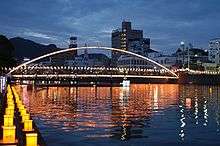Tōrō nagashi

Tōrō nagashi (灯籠流し) is a Japanese ceremony in which participants float paper lanterns (chōchin) down a river; tōrō is another word for "lantern," while nagashi means "cruise" or "flow." This activity is traditionally performed on the final evening of the Bon Festival in the belief that it will help to guide the souls of the departed to the spirit world.
The ceremony may take place on other days of the year for such reasons as the commemoration of those lost in the bombing of Hiroshima and those who died on Japan Airlines Flight 123. It is also performed in other regions of the world, such as Hawaii, to commemorate the end of World War II. The Bon Festival takes place on the thirteenth to sixteenth of August or July, depending on the calendar used. Traditional Japanese beliefs state that humans come from water, so the lanterns represent their bodies returning to water and in particular to the sea. White paper lanterns are used to represent those who died in the past year.
See also
- Spirit Boat Procession
- Diwali Indian light festival
- Loi Krathong Thai lantern festival
External links
| Wikimedia Commons has media related to Tōrō nagashi. |
- Lantern Floating Hawaii Official site of Hawaii's largest Tourou Nagashi ceremony, held at Magic Island in Honolulu. Presented by Shinnyo-en Hawaii and the Na Lei Aloha Foundation.
- Tourou Nagashi Video A videoblog entry from the 2006 Tourou Nagashi ceremony in Honolulu.
- Web site of the San Francisco Bay Area Peace Lantern Ceremony, held annually since 2002
- Web site of 'From Hiroshima to Hope', in Seattle, the largest commemoration of the bombing of Hiroshima outside Japan.